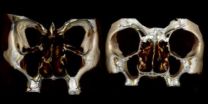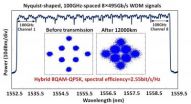(Press-News.org) Once Andrei Tokmakoff gets his new laser laboratory operational later this year, he will use the world's shortest infrared light pulses to pluck molecular bonds like a stringed musical instrument.
Tokmakoff, the Henry G. Gale Distinguished Service Professor of Chemistry, arrived at the University of Chicago in January to tackle new problems in biology with the aid of ultrafast vibrational spectroscopy methods that he has developed.
"He does very sophisticated spectroscopy, in particular vibrational spectroscopy," said Richard Jordan, professor and chairman of chemistry. "He has developed advanced, laser-based methods that can probe how the bonds in molecules stretch and bend."
Tokmakoff's hire is a major component of the chemistry department's effort to expand from its current 22 faculty members to 27 or 28 within the next two years. "We have targeted three or four important areas to build in. One of them is biological chemistry, those aspects of chemistry that deal with biological problems," Jordan said.
Tokmakoff does both physical and biophysical chemistry. Physical chemistry — studying the behavior of materials and chemical reactions at the atomic and molecular level — has a long tradition of excellence at UChicago. Biophysical chemistry has emerged more recently as a major campus initiative that encompasses the James Franck Institute and the Institute for Biophysical Dynamics (Tokmakoff is a member of both) and the Biophysical Sciences Program.
A special liquid
Tokmakoff seeks to understand the special behavior of liquid water, protein-water interactions, and the dynamics of protein folding and binding. This includes how hydrogen bonds connect different molecules to one another and how these bonds rearrange themselves so that the liquid flows.
"These are not phenomena that can be described simply in terms of the motion of one molecule," said Tokmakoff, formerly of the Massachusetts Institute of Technology. "Many of the reasons why it's so vital to life processes also originate not just as one individual molecule, but how they all collectively interact with biological molecules."
Tokmakoff generates light bursts at 40-femtosecond intervals with ultrafast vibrational spectroscopy. "Light travels the diameter of a cell or a small pollen grain in that time," he said. Molecules barely move in 40 femtoseconds (a quadrillionth of a second), which corresponds to the period of a molecular bond vibration.
These ultra-short pulses of infrared radiation "act a bit like stop-motion photography," Tokmakoff said. Although it's not real photography, "a sequence of ultra-short bursts of light can capture the motion of an object by freezing it at different points in time. We don't physically image the molecules, but infrared radiation interacts with the bond vibrations of water," he said. These interactions reveal the structure of the object in question.
"Through a sequence of these pulses we can design experiments that give us a lot of information about the molecular structure before it changes, even if it is constantly moving," Tokmakoff explained.
At MIT, Tokmakoff applied ultrafast spectroscopic methods to key problems in chemistry. He discovered that the molecular structure of water evolves in big jumps when the molecules collectively change the connectivity of their hydrogen bonds. "It's a very strange behavior, but the fact that water does this and does it often really makes it a liquid and allows it to flow."
"Beyond water we're also applying the same sorts of methods to a lot of problems in molecular biophysics. Many of the problems that exist there share the characteristics with water that they are messy, complicated, constantly evolving molecular structures," Tokmakoff said, including protein folding.
Disordered yet functional
Tokmakoff's group has a special interest in disordered proteins. Molecular biologists primarily conceive of proteins as well-defined, three-dimensional, biologically active structures. "The reason we conceive them that way is because that's what our experiments tell us," he said. In fact, many proteins are either partially or fully disordered, yet they can still be functional.
Scientists often talk of proteins connecting like a lock and key, but that analogy falls far short of explaining how two structurally disorganized molecules manage to find and then connect with one another.
Two proteins exhibiting no apparent structure wander around randomly in a cell. When they encounter one another they somehow know that they were made for each other, and they often do this with more efficiency and speed than current theory can explain.
"You've got one molecule of thousands and thousands in a cell, and somehow it's miraculously going to find its one partner and do it so efficiently—it's just mind-boggling," Tokmakoff said. Tucked into the many aspects of that problem is the molecular fine print: how a protein recognizes and binds to its partner.
Many classes of proteins exhibit such behavior, and Tokmakoff would like to unlock the secret to that behavior. "We're in the middle of all kinds of cool experiments," he said.
INFORMATION:
Watery research theme to flow through new Tokmakoff lab
2013-03-12
ELSE PRESS RELEASES FROM THIS DATE:
Anemia drugs does not improve health of anemic heart failure patients
2013-03-12
Researchers from Sahlgrenska Academy, University of Gothenburg, Sweden, have found that a commonly used drug to treat anemia in heart failure patients does not improve patients' health, nor does it reduce their risk of death from heart failure. Results of the international study were presented at the American College of Cardiology's annual meeting in San Francisco on March 10 and published simultaneously online by The New England Journal of Medicine.
Initiated in 2006, the RED-HF (Reduction of Events With Darbepoetin Alfa in Heart Failure) trial involved 2,278 anemic ...
Heat-stressed cows spend more time standing
2013-03-12
Des Moines, IA – A new study by researchers at the University of Arizona and Northwest Missouri State University shows that standing and lying behavior can predict heat stress in cows.
In a presentation at the 2013 ADSA Midwest Branch / ASAS Midwestern Section Meeting, Dr. Jamison Allen explained that predicting heat stress is vital for keeping cows healthy and productive. Cows will pant, eat less and produce less milk when their core body temperature increases.
Allen said cows prefer standing to lying on hot days. Cows stand to allow more of their surface area to disperse ...
Ruptured aneurysm has lasting impact on quality of life
2013-03-12
Philadelphia, Pa. (March 12, 2013) – Ten years after stroke caused by a ruptured aneurysm of the brain, surviving patients have persistent difficulties in several areas affecting quality of life, reports a study in the March issue of Neurosurgery, official journal of the Congress of Neurological Surgeons. The journal is published by Lippincott Williams & Wilkins, a part of Wolters Kluwer Health.
The long-term impact of ruptured aneurysms causing subarachnoid hemorrhage (SAH) highlights the need for "survivorship care plans" comparable to those made for long-term cancer ...
The nose's unheralded neighbor
2013-03-12
Pity the poor maxillary sinuses. Those bulbous pouches on either side of the human nose are known more for trapping mucus and causing sinus infections than anything else. They were thought to be an evolutionary relic of our distant past, with little known present value.
Yet researchers led by the University of Iowa believe the unheralded maxillary sinuses play a fortuitous, integral role in the shape and function of the human nose, even today. After studying faces of African and European origin, the team has concluded that the maxillary sinuses act as a cushion of sorts, ...
Tickling the brain with magnetic stimulation improves memory in schizophrenia
2013-03-12
Philadelphia, PA, March 12, 2013 – Cognitive impairments are disabling for individuals with schizophrenia, and no satisfactory treatments currently exist. These impairments affect a wide range of cognition, including memory, attention, verbal and motor skills, and IQ. They appear in the earliest stages of the disease and disrupt or even prevent normal day-to-day functioning.
Scientists are exploring a variety of strategies to reduce these impairments including "exercising the brain" with specially designed computer games and medications that might improve the function ...
Antibiotic-resistant strain of E. coli increasing among older adults and residents of nursing homes
2013-03-12
Antibiotic-resistant Escherichia coli (E. coli) continues to proliferate, driven largely by expansion of a strain of E. coli know as sequence type ST131. A new study points to hospitals and long-term care facilities (LTCF) as settings in which this antibiotic-resistant strain is increasingly found. The study is published in the April issue of Infection Control and Hospital Epidemiology, the journal of the Society for Healthcare Epidemiology of America.
E. coli is the most common gram-negative pathogen, causing both gastrointestinal disease and extraintestinal infections ...
Infants prefer individuals who punish those not like themselves, Yale researchers find
2013-03-12
Infants as young as nine months old prefer individuals who punish those who are not like them, and this seemingly innate mean streak grows stronger in the next five months of life, a study by researchers at Yale University has found.
Babies, like adults, prefer individuals who like the same things they do. A new study reports that they want individuals who share their tastes to be treated well by others, but want those whose tastes differ from their own to be treated badly. The study of 200 nine- and 14-month-old infants was published online in Psychological Science, ...
New distance record for 400 Gb/s data transmission
2013-03-12
As network carriers debate the next Ethernet standard—and whether transmission speeds of 400 gigabit per second or 1 terabit per second should be the norm—engineers are working on new measures to squeeze next-generation performance out of current-generation systems.
To that end, a team from AT&T has devised a new patent pending technique enabling tuning of the modulation spectral efficiency, which allows, for the first time, 400 Gb/s signals to be sent over today's 100 gigahertz-grid optical networks over ultra-long distances. Spectral efficiency is the information rate ...
Job burnout can severely compromise heart health
2013-03-12
Americans work longer hours, take fewer vacation days, and retire later than employees in other industrialized countries around the globe. With such demanding careers, it's no surprise that many experience job burnout — physical, cognitive, and emotional exhaustion that results from stress at work. Researchers have found that burnout is also associated with obesity, insomnia, and anxiety.
Now Dr. Sharon Toker of Tel Aviv University's Faculty of Management and her fellow researchers — Profs. Samuel Melamed, Shlomo Berliner, David Zeltser and Itzhak Shpira of TAU's Sackler ...
Ultra-high-speed optical communications link sets new power efficiency record
2013-03-12
Ultrafast supercomputers that operate at speeds 100 times faster than current systems are now one step closer to reality. A team of IBM researchers working on a U.S. Defense Advanced Research Projects Agency (DARPA)-funded program have found a way to transmit massive amounts of data with unprecedentedly low power consumption.
The team will describe their prototype optical link, which shatters the previous power efficiency record by half at the Optical Fiber Communication Conference and Exposition/National Fiber Optic Engineers Conference (OFC/NFOEC) in Anaheim, Calif. ...




